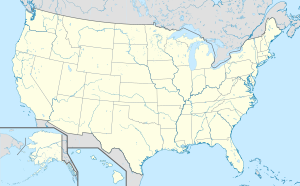Dale Creek Crossing
Coordinates: 41 ° 6 ′ 13 ″ N , 105 ° 27 ′ 17 ″ W.
| Dale Creek Crossing | ||
|---|---|---|
| The first wooden Dale Creek Bridge in 1868 | ||
| use | Railway bridge | |
| Crossing of | Dale Creek | |
| place | Laramie , Wyoming | |
| construction | Trestle Bridge | |
| overall length | 219 m (wood), 215 m (iron) | |
| Longest span | 12 m | |
| building-costs | US $ 200,000 (wood) US $ 39,450 (iron) |
|
| opening | 1868 (wood), 1876 (iron) | |
| closure | 1901 | |
| location | ||
|
|
||
The former section of the Omaha – Ogden railway over the canyon of Dale Creek , known as Dale Creek Crossing , existed between 1868 and 1901 and was part of the railway connection established by the Union Pacific Railroad between Omaha and Promontory Summit . It is located in the Laramie Mountains between Cheyenne and Laramie in the state of Wyoming and consisted of approximately 220 meters long trestle bridges ( Dale Creek Bridge ), the design of which was changed several times before they were dismantled in 1901. The parts of the substructures of the various structures that have survived to this day were placed under monument protection in 1986 when they were included in the National Register of Historic Places .
Wooden construction 1868
During the construction of the transcontinental railway line between Omaha and Sacramento between 1863 and 1869, the construction crews of the Union Pacific Railroad reached the highest point of the section at Sherman Summit at 2,514 meters in the spring of 1868 . Six kilometers west (and 35 miles west of Cheyenne ) the almost 40 m deep canyon of Dale Creek had to be crossed. For this purpose, a 219 m long scaffolding pillar viaduct ( Trestle Bridge ) made of wood was built, the central part of which consisted of thirteen 12.3 m long truss girders ( Howe Truss with track below) between the scaffolding piers, which were built on foundations made of natural stone masonry . The pine came from the Michigan forests , was cut to size in Chicago and transported to the construction site by rail. Due to the prevailing strong winds, work on the bridge had to be temporarily interrupted and the structure secured with a large number of guy ropes , the maximum speed of the trains was limited to 6 km / h for the crossing. The construction of the bridge took about a month and was completed on April 23, 1868, in the following month the construction crews reached Laramie to the northwest .
Iron construction 1876
Due to the high fire hazard of the wooden bridge , the first Dale Creek Bridge was replaced in 1876 by a wrought iron structure prefabricated by the American Bridge Company in Chicago. The pillars were erected on the existing foundations and carried trusses with the track above. The delicate appearance of the second Dale Creek Bridge gave her the nickname Spider Web (dt. Spider web ). The wooden structures of the driveways were preserved, the western part was destroyed in November 1884 by a fire that also damaged parts of the adjacent iron longitudinal beams. One year after the repair, the trusses were replaced by girder bridges in 1885 to enable them to be used by heavier locomotives and railroad cars . Presumably in the same year the driveways were replaced by abutments made of natural stone masonry.
In 1901 the Union Pacific Railroad relocated the route and replaced the bridge to cross the canyon with a 274 m long embankment about two kilometers southeast, the Trestle Bridge was later dismantled and the girder bridges were reused on other sections of the route. The foundations of the scaffold piers and the abutments, which have remained almost unchanged to this day, were added to the National Register of Historic Places in 1986 (NRHP #: 86001027).
literature
- Mark L. Gardner: Dale Creek Crossing. In: Annals of Wyoming. Vol. 60, No. 1,2 1988, pp. 2-7.
Web links
Individual evidence
- ↑ Stephen E. Ambrose: Nothing Like It In the World: The Men Who Built the Transcontinental Railroad 1863-1869. Simon and Schuster, 2005, ISBN 978-0-7432-0317-3 , pp. 259-262.
- ^ A b Mark L. Gardner: Dale Creek Crossing. In: Annals of Wyoming. Vol. 60, No. 1,2 1988, pp. 2-7.
- ^ Richard C. Williams: Dale Creek Crossing - National Register of Historic Places Inventory Nomination Form. United State Department of the Interior, National Park Service, 1984.




